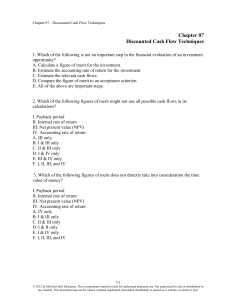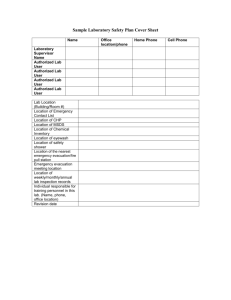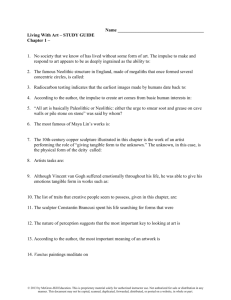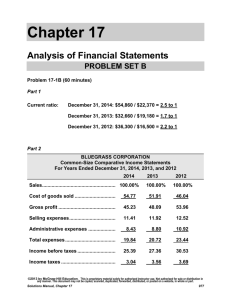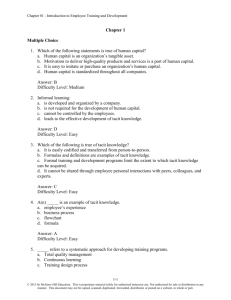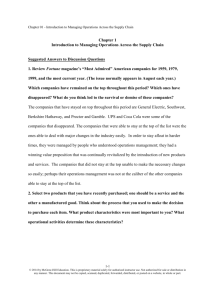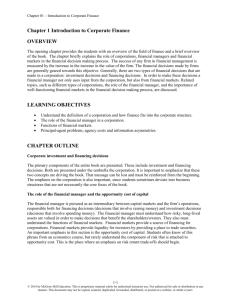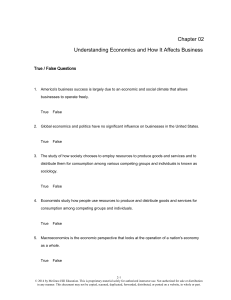Sample of Test Bank for Managing Operations
advertisement
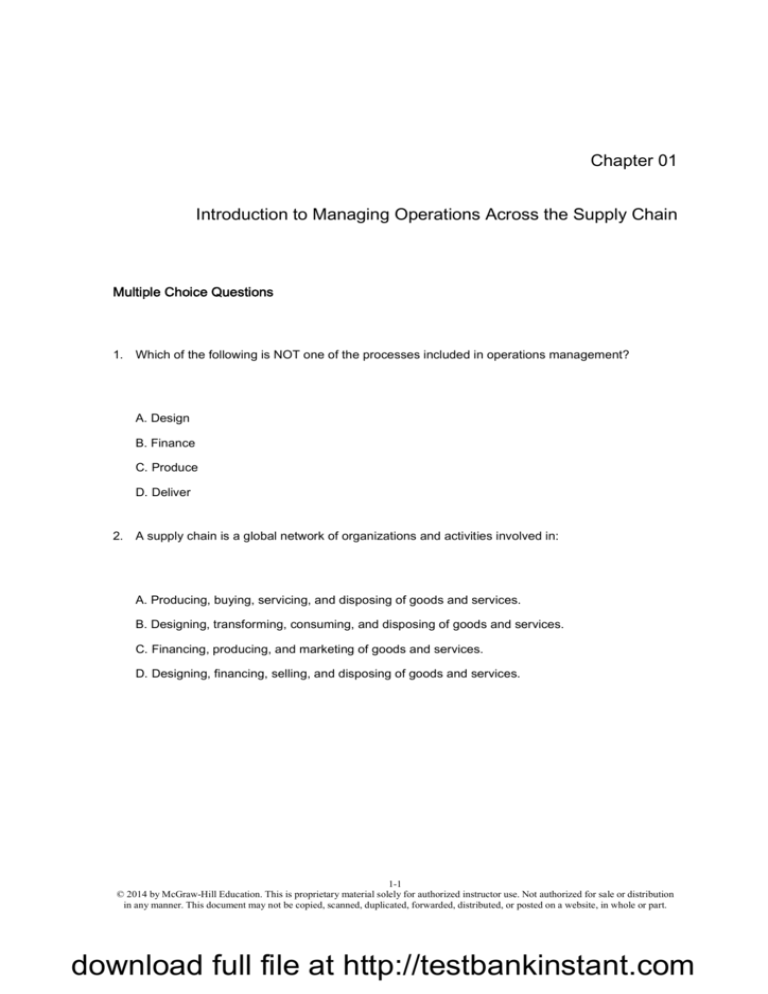
Chapter 01 Introduction to Managing Operations Across the Supply Chain Multiple Choice Questions 1. Which of the following is NOT one of the processes included in operations management? A. Design B. Finance C. Produce D. Deliver 2. A supply chain is a global network of organizations and activities involved in: A. Producing, buying, servicing, and disposing of goods and services. B. Designing, transforming, consuming, and disposing of goods and services. C. Financing, producing, and marketing of goods and services. D. Designing, financing, selling, and disposing of goods and services. 1-1 © 2014 by McGraw-Hill Education. This is proprietary material solely for authorized instructor use. Not authorized for sale or distribution in any manner. This document may not be copied, scanned, duplicated, forwarded, distributed, or posted on a website, in whole or part. download full file at http://testbankinstant.com 3. Operations managers answer questions of what, how, when, where, and who by defining both the ___________ and _____________ aspects of the operations management system. A. Financing and capacity B. Marketing and delivery C. Structural and infrastructural D. Production and accounting 4. Structural operations management decisions include: A. Workforce, capacity, and facilities. B. Workforce, production planning, and materials controls. C. Capacity, facilities, and technology. D. Materials controls, supply chain, and value definition. 5. Joe Jones was asked to undertake a project to determine the resources and capacity his firm would need in the next three to 10 years. These types of decisions are considered to be: A. Infrastructural aspects of operations management. B. Positional aspects of operations management. C. Assessment aspects of operations management. D. Structural aspects of operations management. 1-2 © 2014 by McGraw-Hill Education. This is proprietary material solely for authorized instructor use. Not authorized for sale or distribution in any manner. This document may not be copied, scanned, duplicated, forwarded, distributed, or posted on a website, in whole or part. download full file at http://testbankinstant.com 6. Physical goods can be differentiated from services in the operations management process by: A. Longer lead times and they can be inventoried. B. More capital intensive and short lead times. C. More labor intensive and longer lead times. D. More expensive and easier to control. 7. Which of the following functions would NOT have to think about "processes"? A. Logistics management B. Production management C. Supply management D. Accounting E. All of these have to think about "processes." 8. Which of the following statements about operations management processes is NOT true? A. Inputs to operations management processes can be materials, people, and/or information. B. Outputs of operations management processes are always tangible goods. C. Operations management processes involve transformation of inputs into valuable outputs. D. Design of operations processes should reflect what customers want. 1-3 © 2014 by McGraw-Hill Education. This is proprietary material solely for authorized instructor use. Not authorized for sale or distribution in any manner. This document may not be copied, scanned, duplicated, forwarded, distributed, or posted on a website, in whole or part. download full file at http://testbankinstant.com 9. Growth of the supply chain management perspective in operations management results from the advent of: A. Technology and infrastructure advances. B. Collaborative networks. C. A focus on core capabilities. D. All of these. 10. During the "mass production" era, operations management focused primarily on: A. Production and design. B. Internal production. C. The global supply chain. D. Sales, production and design. 11. While there is overlap between operations management and supply chain management, the two are different in that: A. Operations management focuses on production, supply chain management focuses on supply and logistics. B. Operations management focuses on tangible goods, supply chain management focuses on services. C. Operations management focuses on processes, supply chain management focuses on relationships and flows. D. All of these. 1-4 © 2014 by McGraw-Hill Education. This is proprietary material solely for authorized instructor use. Not authorized for sale or distribution in any manner. This document may not be copied, scanned, duplicated, forwarded, distributed, or posted on a website, in whole or part. download full file at http://testbankinstant.com 12. Johnson Company makes widgets, which it then sends to Smith Company. Smith Company puts the widgets in packages. Smith Company is considered by Johnson to be a: A. Critical customer. B. Upstream product supplier. C. Aftermarket supplier. D. Downstream product supplier. 13. To an operations manager, the "critical customer" is: A. The person who buys a product. B. The person who has the greatest impact on design, sales, and growth opportunities for the product. C. The Echelon 1 customer. D. The person who uses the product. 14. Which functional activities are the most related to operations management attempts to manage the flow of materials and information in a firm? A. Finance, accounting, and supply management B. Logistics, finance and supply management C. Logistics, supply, and customer management D. Customer, finance, and logistics management 1-5 © 2014 by McGraw-Hill Education. This is proprietary material solely for authorized instructor use. Not authorized for sale or distribution in any manner. This document may not be copied, scanned, duplicated, forwarded, distributed, or posted on a website, in whole or part. download full file at http://testbankinstant.com 15. Jones Manufacturing sells a part to Lear Corporation. Lear puts this part into a radio, which Lear then sells to Ford. From Ford's point of view, Jones Manufacturing is a(n) __________ supplier. A. Echelon 1 B. Echelon 2 C. Tier 1 D. Tier 2 16. Operations management is: A. The management of production. B. The management of services. C. The management of processes. D. The management of physicians. 17. Which of the following statements are reasons why operations management is important? A. Efficient and productive operations drive the economic well-being of nations. B. Operations management is responsible for much of the value created by organizations. C. Operations management is a key source of competitive differentiation among firms. D. All of these are reasons why operations management is important. 1-6 © 2014 by McGraw-Hill Education. This is proprietary material solely for authorized instructor use. Not authorized for sale or distribution in any manner. This document may not be copied, scanned, duplicated, forwarded, distributed, or posted on a website, in whole or part. download full file at http://testbankinstant.com 18. A process is: A. A set of planned steps used to achieve an objective. B. A system of activities that transforms inputs into valuable outputs. C. A system of decisions. D. A combined effort by people who want to get something done. 19. Which of the following statements is NOT true regarding supply chain management? A. Globalization has slowed the growth of supply chain management. B. Supply chain management is a way of viewing operations management. C. Supply chain management has grown as a result of a focus on core competencies. D. Supply chain management is about making the most of relationships with suppliers. 20. Every organization operates which of the following types of supply chains? A. Product and tangible goods supply chains. B. Information and personnel supply chains. C. Direct and indirect supply chains. D. Product and resource/technology supply chains. 1-7 © 2014 by McGraw-Hill Education. This is proprietary material solely for authorized instructor use. Not authorized for sale or distribution in any manner. This document may not be copied, scanned, duplicated, forwarded, distributed, or posted on a website, in whole or part. download full file at http://testbankinstant.com 21. Which of the following factors is NOT a major change driver that supply chain managers are concerned about? A. Technology changes B. Regulatory changes C. Global political changes D. Supply chain managers are concerned about All of these changes. 22. Different levels of planning in supply chain operations management include: A. General and detailed planning. B. Strategic, tactical, and operational planning. C. Long-term and short-term planning. D. Logistical, operational, and procurement planning. 23. An example of strategic planning is: A. Deciding where to locate a new manufacturing plant. B. Forecasting next week's demand of a given product item. C. Targeting customer demand for aggregate product families. D. Setting inventory levels for a given product. 1-8 © 2014 by McGraw-Hill Education. This is proprietary material solely for authorized instructor use. Not authorized for sale or distribution in any manner. This document may not be copied, scanned, duplicated, forwarded, distributed, or posted on a website, in whole or part. download full file at http://testbankinstant.com 24. Which of the following decisions would NOT be under the direct control of operations managers? A. What resources will be used to satisfy customer demand? B. What customers should be targeted with greatest priority? C. What suppliers should provide needed inputs? D. What mode of transportation should be used to ship products? 25. Customer service management connects what functional groups? A. Supply management, marketing, and finance. B. Logistics management, sales and distribution, and product engineering. C. Marketing, logistics management, and sales and distribution. D. Human resources management, marketing, and finance. 1-9 © 2014 by McGraw-Hill Education. This is proprietary material solely for authorized instructor use. Not authorized for sale or distribution in any manner. This document may not be copied, scanned, duplicated, forwarded, distributed, or posted on a website, in whole or part. download full file at http://testbankinstant.com Chapter 01 Introduction to Managing Operations Across the Supply Chain Answer Key Multiple Choice Questions 1. Which of the following is NOT one of the processes included in operations management? A. Design B. Finance C. Produce D. Deliver Design, supply, produce, and deliver are operations management processes. Finance is not. AACSB: Reflective Thinking Blooms: Remember Learning Objective: 01-01 Explain what operations management is and why it is important. Level of Difficulty: 1 Easy Topic Area: A Broad Definition of Supply Chain Operations Management 1-10 © 2014 by McGraw-Hill Education. This is proprietary material solely for authorized instructor use. Not authorized for sale or distribution in any manner. This document may not be copied, scanned, duplicated, forwarded, distributed, or posted on a website, in whole or part. download full file at http://testbankinstant.com 2. A supply chain is a global network of organizations and activities involved in: A. Producing, buying, servicing, and disposing of goods and services. B. Designing, transforming, consuming, and disposing of goods and services. C. Financing, producing, and marketing of goods and services. D. Designing, financing, selling, and disposing of goods and services. The organizations and activities in a supply chain are involved in designing, transforming, consuming, and disposing of goods and services. AACSB: Reflective Thinking Blooms: Remember Learning Objective: 01-01 Explain what operations management is and why it is important. Level of Difficulty: 1 Easy Topic Area: A Broad Definition of Supply Chain Operations Management 3. Operations managers answer questions of what, how, when, where, and who by defining both the ___________ and _____________ aspects of the operations management system. A. Financing and capacity B. Marketing and delivery C. Structural and infrastructural D. Production and accounting Structural and infrastructural aspects of operations management must be defined to answer questions of what, how, when, where, and who. AACSB: Reflective Thinking Blooms: Remember Learning Objective: 01-02 Describe the major decisions that operations managers typically make. Level of Difficulty: 2 Medium 1-11 © 2014 by McGraw-Hill Education. This is proprietary material solely for authorized instructor use. Not authorized for sale or distribution in any manner. This document may not be copied, scanned, duplicated, forwarded, distributed, or posted on a website, in whole or part. download full file at http://testbankinstant.com Topic Area: A Broad Definition of Supply Chain Operations Management 4. Structural operations management decisions include: A. Workforce, capacity, and facilities. B. Workforce, production planning, and materials controls. C. Capacity, facilities, and technology. D. Materials controls, supply chain, and value definition. Structural decisions include capacity, facilities, technology, and the supply chain network. The other decisions are infrastructural decisions. AACSB: Reflective Thinking Blooms: Remember Learning Objective: 01-02 Describe the major decisions that operations managers typically make. Level of Difficulty: 2 Medium Topic Area: A Broad Definition of Supply Chain Operations Management 5. Joe Jones was asked to undertake a project to determine the resources and capacity his firm would need in the next three to 10 years. These types of decisions are considered to be: A. Infrastructural aspects of operations management. B. Positional aspects of operations management. C. Assessment aspects of operations management. D. Structural aspects of operations management. Resources and capacity are among the structural decisions. AACSB: Reflective Thinking Blooms: Apply Learning Objective: 01-02 Describe the major decisions that operations managers typically make. Level of Difficulty: 2 Medium 1-12 © 2014 by McGraw-Hill Education. This is proprietary material solely for authorized instructor use. Not authorized for sale or distribution in any manner. This document may not be copied, scanned, duplicated, forwarded, distributed, or posted on a website, in whole or part. download full file at http://testbankinstant.com Topic Area: A Broad Definition of Supply Chain Operations Management 6. Physical goods can be differentiated from services in the operations management process by: A. Longer lead times and they can be inventoried. B. More capital intensive and short lead times. C. More labor intensive and longer lead times. D. More expensive and easier to control. Physical goods typically have longer lead times than services and can be inventoried (services typically cannot). See Table 1-1. AACSB: Reflective Thinking Blooms: Remember Learning Objective: 01-02 Describe the major decisions that operations managers typically make. Level of Difficulty: 1 Easy Topic Area: A Broad Definition of Supply Chain Operations Management 7. Which of the following functions would NOT have to think about "processes"? A. Logistics management B. Production management C. Supply management D. Accounting E. All of these have to think about "processes." All functions must think about processes. AACSB: Reflective Thinking Blooms: Remember Learning Objective: 01-03 Explain the role of processes and "process thinking" in operations management. Level of Difficulty: 1 Easy 1-13 © 2014 by McGraw-Hill Education. This is proprietary material solely for authorized instructor use. Not authorized for sale or distribution in any manner. This document may not be copied, scanned, duplicated, forwarded, distributed, or posted on a website, in whole or part. download full file at http://testbankinstant.com Topic Area: A Broad Definition of Supply Chain Operations Management 8. Which of the following statements about operations management processes is NOT true? A. Inputs to operations management processes can be materials, people, and/or information. B. Outputs of operations management processes are always tangible goods. C. Operations management processes involve transformation of inputs into valuable outputs. D. Design of operations processes should reflect what customers want. Outputs of operations management processes can be services. AACSB: Reflective Thinking Blooms: Remember Learning Objective: 01-03 Explain the role of processes and "process thinking" in operations management. Level of Difficulty: 2 Medium Topic Area: A Broad Definition of Supply Chain Operations Management 9. Growth of the supply chain management perspective in operations management results from the advent of: A. Technology and infrastructure advances. B. Collaborative networks. C. A focus on core capabilities. D. All of these. In addition to the three listed alternatives, reduction in trade barriers also contributed to growth of the supply chain perspective. AACSB: Reflective Thinking Blooms: Remember Learning Objective: 01-04 Explain what the supply chain is and what it means to view operations management using a "supply chain perspective." 1-14 © 2014 by McGraw-Hill Education. This is proprietary material solely for authorized instructor use. Not authorized for sale or distribution in any manner. This document may not be copied, scanned, duplicated, forwarded, distributed, or posted on a website, in whole or part. download full file at http://testbankinstant.com Level of Difficulty: 1 Easy Topic Area: Operations Management Yesterday and Today 10. During the "mass production" era, operations management focused primarily on: A. Production and design. B. Internal production. C. The global supply chain. D. Sales, production and design. In the mass production era, the operations focus was on internal production. AACSB: Reflective Thinking Blooms: Remember Learning Objective: 01-04 Explain what the supply chain is and what it means to view operations management using a "supply chain perspective." Level of Difficulty: 2 Medium Topic Area: Operations Management Yesterday and Today 1-15 © 2014 by McGraw-Hill Education. This is proprietary material solely for authorized instructor use. Not authorized for sale or distribution in any manner. This document may not be copied, scanned, duplicated, forwarded, distributed, or posted on a website, in whole or part. download full file at http://testbankinstant.com 11. While there is overlap between operations management and supply chain management, the two are different in that: A. Operations management focuses on production, supply chain management focuses on supply and logistics. B. Operations management focuses on tangible goods, supply chain management focuses on services. C. Operations management focuses on processes, supply chain management focuses on relationships and flows. D. All of these. The key distinction is that supply chain management focuses on relationships and flows, whereas operations management focuses on processes. AACSB: Reflective Thinking Blooms: Apply Learning Objective: 01-04 Explain what the supply chain is and what it means to view operations management using a "supply chain perspective." Level of Difficulty: 1 Easy Topic Area: Viewing Operations Management from a Supply Chain Management Perspective 1-16 © 2014 by McGraw-Hill Education. This is proprietary material solely for authorized instructor use. Not authorized for sale or distribution in any manner. This document may not be copied, scanned, duplicated, forwarded, distributed, or posted on a website, in whole or part. download full file at http://testbankinstant.com 12. Johnson Company makes widgets, which it then sends to Smith Company. Smith Company puts the widgets in packages. Smith Company is considered by Johnson to be a: A. Critical customer. B. Upstream product supplier. C. Aftermarket supplier. D. Downstream product supplier. Companies that enhance finished goods are considered downstream product suppliers. AACSB: Reflective Thinking Blooms: Apply Learning Objective: 01-05 Identify the partners and functional groups that work together in operations management. Level of Difficulty: 2 Medium Topic Area: Viewing Operations Management from a Supply Chain Perspective 13. To an operations manager, the "critical customer" is: A. The person who buys a product. B. The person who has the greatest impact on design, sales, and growth opportunities for the product. C. The Echelon 1 customer. D. The person who uses the product. The critical customer is one who has the greatest impact on design, sales, and growth opportunities. AACSB: Reflective Thinking Blooms: Remember Learning Objective: 01-05 Identify the partners and functional groups that work together in operations management. Level of Difficulty: 1 Easy 1-17 © 2014 by McGraw-Hill Education. This is proprietary material solely for authorized instructor use. Not authorized for sale or distribution in any manner. This document may not be copied, scanned, duplicated, forwarded, distributed, or posted on a website, in whole or part. download full file at http://testbankinstant.com Topic Area: Viewing Operations Management from a Supply Chain Management Perspective 14. Which functional activities are the most related to operations management attempts to manage the flow of materials and information in a firm? A. Finance, accounting, and supply management B. Logistics, finance and supply management C. Logistics, supply, and customer management D. Customer, finance, and logistics management Supply management, logistics management, and customer management are the functions most directly related to the flows of both materials and information. Finance and accounting are primarily about managing capital and reporting information. AACSB: Reflective Thinking Blooms: Remember Learning Objective: 01-06 Define the planning activities associated with managing operations across the supply chain. Level of Difficulty: 1 Easy Topic Area: Viewing Operations Management from a Supply Chain Management Perspective 1-18 © 2014 by McGraw-Hill Education. This is proprietary material solely for authorized instructor use. Not authorized for sale or distribution in any manner. This document may not be copied, scanned, duplicated, forwarded, distributed, or posted on a website, in whole or part. download full file at http://testbankinstant.com 15. Jones Manufacturing sells a part to Lear Corporation. Lear puts this part into a radio, which Lear then sells to Ford. From Ford's point of view, Jones Manufacturing is a(n) __________ supplier. A. Echelon 1 B. Echelon 2 C. Tier 1 D. Tier 2 A supplier's supplier is known as a Tier 2 supplier. AACSB: Reflective Thinking Blooms: Apply Learning Objective: 01-05 Identify the partners and functional groups that work together in operations management. Level of Difficulty: 2 Medium Topic Area: Viewing Operations Management from a Supply Chain Management Perspective 16. Operations management is: A. The management of production. B. The management of services. C. The management of processes. D. The management of physicians. "Processes" comprehends all of the aspects of operations management. The other answers are just possible components of operations management. AACSB: Reflective Thinking Blooms: Remember Learning Objective: 01-01 Explain what operations management is and why it is important. Level of Difficulty: 1 Easy 1-19 © 2014 by McGraw-Hill Education. This is proprietary material solely for authorized instructor use. Not authorized for sale or distribution in any manner. This document may not be copied, scanned, duplicated, forwarded, distributed, or posted on a website, in whole or part. download full file at http://testbankinstant.com Topic Area: A Broad Definition of Supply Chain Operations Management 17. Which of the following statements are reasons why operations management is important? A. Efficient and productive operations drive the economic well-being of nations. B. Operations management is responsible for much of the value created by organizations. C. Operations management is a key source of competitive differentiation among firms. D. All of these are reasons why operations management is important. Operations management affects both macroeconomic and individual firm outcomes AACSB: Reflective Thinking Blooms: Remember Learning Objective: 01-01 Explain what operations management is and why it is important. Level of Difficulty: 1 Easy Topic Area: A Broad Definition of Supply Chain Operations Management 18. A process is: A. A set of planned steps used to achieve an objective. B. A system of activities that transforms inputs into valuable outputs. C. A system of decisions. D. A combined effort by people who want to get something done. Processes involve transformation, and they may or may not involve people. AACSB: Reflective Thinking Blooms: Understand Learning Objective: 01-03 Explain the role of processes and "process thinking" in operations management. Level of Difficulty: 2 Medium Topic Area: A Broad Definition of Supply Chain Operations Management 1-20 © 2014 by McGraw-Hill Education. This is proprietary material solely for authorized instructor use. Not authorized for sale or distribution in any manner. This document may not be copied, scanned, duplicated, forwarded, distributed, or posted on a website, in whole or part. download full file at http://testbankinstant.com 19. Which of the following statements is NOT true regarding supply chain management? A. Globalization has slowed the growth of supply chain management. B. Supply chain management is a way of viewing operations management. C. Supply chain management has grown as a result of a focus on core competencies. D. Supply chain management is about making the most of relationships with suppliers. Globalization has increased the growth of supply chain management. SCM involves relationships with customers and partners, not just suppliers. AACSB: Reflective Thinking Blooms: Understand Learning Objective: 01-04 Explain what the supply chain is and what it means to view operations management using a "supply chain perspective." Level of Difficulty: 2 Medium Topic Area: Viewing Operations Management from a Supply Chain Management Perspective 20. Every organization operates which of the following types of supply chains? A. Product and tangible goods supply chains. B. Information and personnel supply chains. C. Direct and indirect supply chains. D. Product and resource/technology supply chains. Product supply chains manage flows of goods and services. Resource/technology supply chains manage acquisitions and flows of equipment, facilities, workers, product designs, and so on. AACSB: Reflective Thinking Blooms: Understand Learning Objective: 01-04 Explain what the supply chain is and what it means to view operations management using a "supply 1-21 © 2014 by McGraw-Hill Education. This is proprietary material solely for authorized instructor use. Not authorized for sale or distribution in any manner. This document may not be copied, scanned, duplicated, forwarded, distributed, or posted on a website, in whole or part. download full file at http://testbankinstant.com chain perspective." Level of Difficulty: 2 Medium Topic Area: Viewing Operations Management from a Supply Chain Management Perspective 21. Which of the following factors is NOT a major change driver that supply chain managers are concerned about? A. Technology changes B. Regulatory changes C. Global political changes D. Supply chain managers are concerned about All of these changes. Supply chain managers also track market changes, including social issues such as sustainability. AACSB: Reflective Thinking Blooms: Understand Learning Objective: 01-04 Explain what the supply chain is and what it means to view operations management using a "supply chain perspective." Level of Difficulty: 2 Medium Topic Area: Viewing Operations Management from a Supply Chain Management Perspective 22. Different levels of planning in supply chain operations management include: A. General and detailed planning. B. Strategic, tactical, and operational planning. C. Long-term and short-term planning. D. Logistical, operational, and procurement planning. Strategic, tactical, and operational planning address different time frames and levels of detail. AACSB: Reflective Thinking 1-22 © 2014 by McGraw-Hill Education. This is proprietary material solely for authorized instructor use. Not authorized for sale or distribution in any manner. This document may not be copied, scanned, duplicated, forwarded, distributed, or posted on a website, in whole or part. download full file at http://testbankinstant.com Blooms: Remember Learning Objective: 01-06 Define the planning activities associated with managing operations across the supply chain. Level of Difficulty: 1 Easy Topic Area: Viewing Operations Management from a Supply Chain Management Perspective 23. An example of strategic planning is: A. Deciding where to locate a new manufacturing plant. B. Forecasting next week's demand of a given product item. C. Targeting customer demand for aggregate product families. D. Setting inventory levels for a given product. Strategic planning addresses long-term decisions involving large amounts of money. AACSB: Reflective Thinking Blooms: Understand Learning Objective: 01-06 Define the planning activities associated with managing operations across the supply chain. Level of Difficulty: 2 Medium Topic Area: Viewing Operations Management from a Supply Chain Management Perspective 24. Which of the following decisions would NOT be under the direct control of operations managers? A. What resources will be used to satisfy customer demand? B. What customers should be targeted with greatest priority? C. What suppliers should provide needed inputs? D. What mode of transportation should be used to ship products? Customer targeting is primarily the responsibility of the marketing function. AACSB: Reflective Thinking Blooms: Remember 1-23 © 2014 by McGraw-Hill Education. This is proprietary material solely for authorized instructor use. Not authorized for sale or distribution in any manner. This document may not be copied, scanned, duplicated, forwarded, distributed, or posted on a website, in whole or part. download full file at http://testbankinstant.com Learning Objective: 01-02 Describe the major decisions that operations managers typically make. Level of Difficulty: 2 Medium Topic Area: A Broad Definition of Supply Chain Operations Management 25. Customer service management connects what functional groups? A. Supply management, marketing, and finance. B. Logistics management, sales and distribution, and product engineering. C. Marketing, logistics management, and sales and distribution. D. Human resources management, marketing, and finance. These groups work together to identify and fulfill customers' needs. AACSB: Reflective Thinking Blooms: Understand Learning Objective: 01-05 Identify the partners and functional groups that work together in operations management. Level of Difficulty: 2 Medium Topic Area: Viewing Operations Management from a Supply Chain Management Perspective 1-24 © 2014 by McGraw-Hill Education. This is proprietary material solely for authorized instructor use. Not authorized for sale or distribution in any manner. This document may not be copied, scanned, duplicated, forwarded, distributed, or posted on a website, in whole or part. download full file at http://testbankinstant.com
